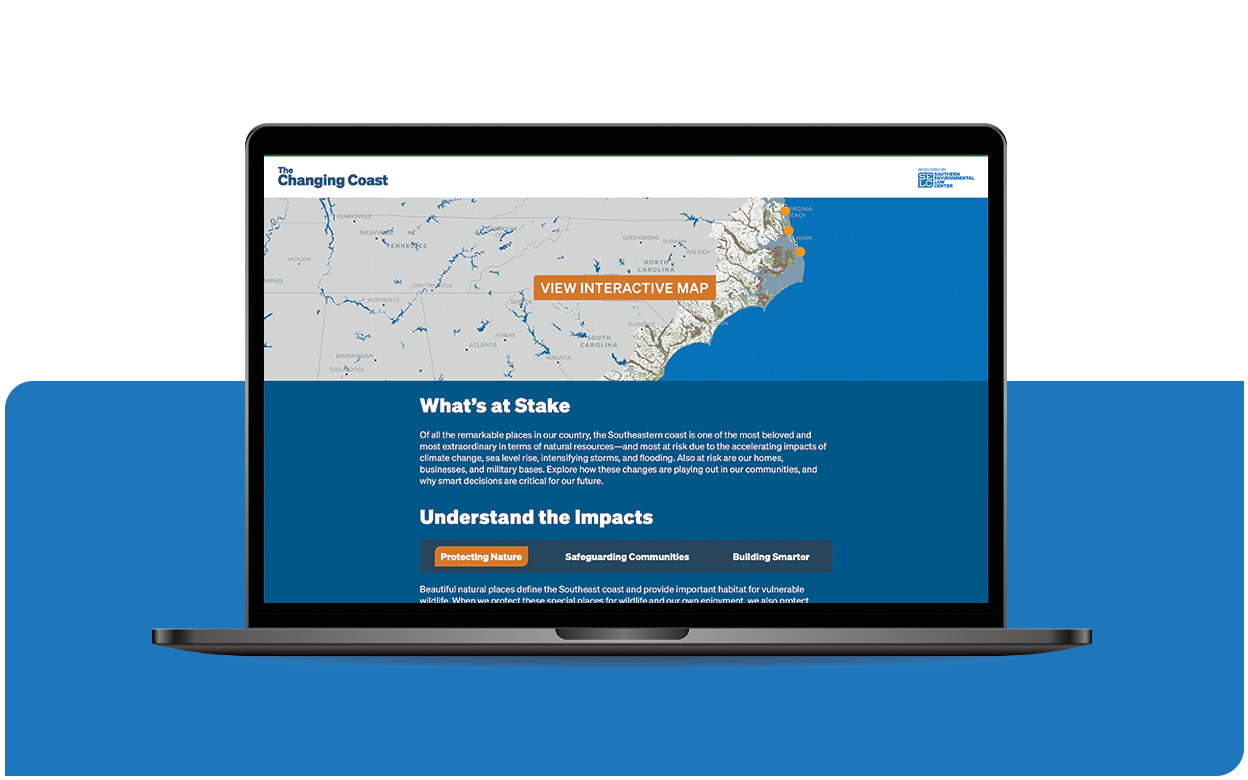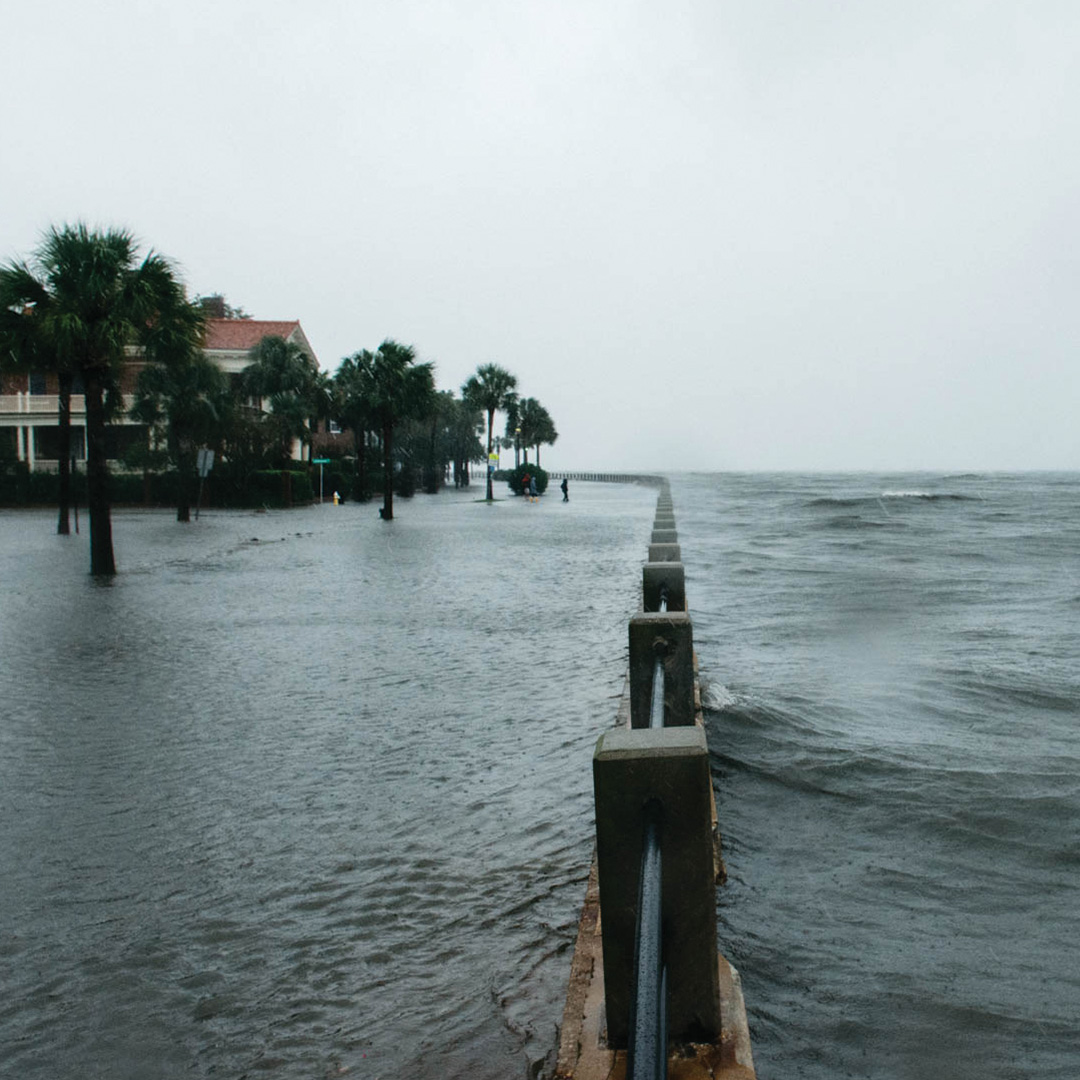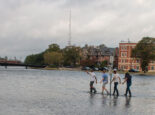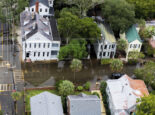The changing coast
Helping coastal communities adapt to rising seas and a changing climate
Climate change and sea level rise contribute to costly, chronic flooding in cities like Charleston and Norfolk. In North Carolina, the shoreline is swiftly eroding. Rising seawater jeopardizes everything from wildlife refuges to military bases.
And the storms that routinely pelt the coast—from summer squalls to ferocious hurricanes—are getting stronger, carrying more moisture, and unleashing more rain.
The Southern coast is one of the nation’s most extraordinary natural treasures, but the barrier islands, salt marshes, and historic shores are undergoing rapid changes. In the balance is the beauty and bounty that provides respite, recreation, and commerce for Southerners and visitors alike.

The Changing Coast
SELC’s geospatial and coastal teams are making waves with the launch of The Changing Coast, a website and interactive map showing how rising seas and a changing climate are reshaping the Southern coast.
The impacts of climate change are putting our beaches at risk, threatening our communities with overwhelming floods, and affecting economies that rely on coastal resources. Responding responsibly to these challenges is critical to our future, and harmful infrastructure like beach armoring and seawalls threaten to exacerbate the damage to our communities.
If we want to continue to live, work, and play in these communities, we’ve got to get serious about protecting natural resources that help us address these threats. If we continue to fill wetlands, build in floodplains, and harden beaches, we’re going to flood our way right out of a thriving, vibrant community.
Andrew Wunderley, Charleston Waterkeeper
Protecting critical wetlands and marshes
Many southern cities were built over filled wetlands. Since that history can’t be changed, it’s critical to protect what wetlands remain. An acre of wetlands can hold up to 330,000 gallons of water, so when wetlands are lost, also lost is that protection. And since wetlands store carbon instead of releasing it to the atmosphere as heat-trapping carbon dioxide, saving them is an important part of preventing climate change from getting worse.
At the same time, coastal marshes and the vast array of wildlife that lives in them are at risk when seas rise, and we must set aside areas for marshes to adapt. When water gets too deep, marshes can move, or migrate, to slightly higher ground. But roads, housing developments and other infrastructure can block those migration spaces, eliminating critical habitat for shellfish, gamefish, and waterfowl that support fishing and hunting industries.
Safeguarding communities from flooding and storms
Not all of our Southern neighbors have the financial means to relocate when storms bear down or when their homes become unlivable because of rising seas and frequent flooding. It is a critical and moral duty to help these communities adapt to rising seas or help them relocate to safer areas.
We are working, often behind the scenes, to create policies that do just that. In South Carolina, we worked with key partners to help pass the Disaster Relief and Resilience Act that aims to tackle flooding and adaptation by establishing a loan and grant program for municipalities to purchase flood prone properties and turn those properties into natural areas for flood storage. In North Carolina, we’re working with partners to establish a new rulemaking that would require property owners to disclose a home’s flood history to prospective buyers, helping future homeowners make smart choices about relocating to areas that might flood.
As our coasts experience more extreme flooding and stronger storm surges, it’s also critical that we rethink the way the national flood insurance system inadvertently subsidizes development in flood-prone areas. At the same time, we also want to ensure that low-wealth communities have the resources needed to access flood insurance so that they can bounce back after major flooding events. In some Southern communities, land has been passed down as heirs’ property through generations in a way that isn’t neatly recorded in traditional deeds, creating a barrier to qualifying for federal emergency assistance and other aid. We are working to make sure communities throughout our region have the tools to respond to flooding and more intense storms as a result of climate change.

Breaking Point
Broken Ground Podcast
Season 3, Episode 2
Smarter solutions for development and infrastructure
Development in areas likely to flood is a recipe for costly catastrophes. Permitting agencies must consider how climate change is re-shaping the coast, and how quickly that is happening.
As communities try to respond to the increasing impacts of climate change, many turn to temporary and damaging tactics like building seawalls and jetties on our Southern beaches, bays, sounds, and tidal creeks. Often, this kind of shoreline armoring accelerates erosion or dramatically alters the natural way sand moves up and down the coast. It may build a bigger beach in one section, but neighboring areas can be stripped almost bare, endangering other properties and damaging critical wildlife habitats. Coastal armoring can also encourage development in areas where flooding and dangerous storm surge is likely, putting lives and property at risk. SELC is working to minimize use of shoreline armoring and will continue to advocate for better long-term resilience solutions.
Additional Resources

Gardening Tidewaters

Flood City

Progress for Who?


